At the midway point of the campaign, Annecy are sitting second in France’s third tier, Championnat National 1. This is a particularly impressive showing from the Haute-Savoie-based side when you consider that they ended last season in 14th place in National 1, spent four seasons in the fourth tier, National 2, before that. Furthermore, before those four seasons, Annecy had been playing in France’s regional amateur divisions since 1993.
A sharp rise in recent years has seen Annecy return to the third tier — a height they haven’t managed to reach since the early ‘90s. Yet, the club doesn’t look content with their current position and are continuing to pose a challenge for promotion to their rivals again this term, with the tantalising prospect of Ligue 2 football well within their grasp based on their performance this term.
Annecy’s current manager, 52-year-old Laurent Guyot, a Ligue 1-winning centre-back and one-time UEFA Champions League semi-finalist (losing out to Serie A giants Juventus) with Nantes in his playing career, took the reins at Parc des Sports back in May having most recently managed Boulogne, with stints at Cercle Brugge, France U16 and U17, and a period as MLS side Toronto FC’s academy director on his CV. Guyot is an experienced manager having started his career as Nantes B boss back in 2005 and so far, the 52-year-old’s experience is proving valuable for title-challenging Annecy, who are looking to continue their impressive ascent up the French football pyramid by conquering the summit of National 1 and embarking on Ligue 2 next.
At present, Annecy are the second-highest goalscorers in National 1, with 27, but their xG of just 19 suggests they’re perhaps unlikely to continue scoring at the rate they have been based on the quality of chances they’ve been taking and creating, as this is a pretty vast overperformance. On the other side of things, however, Annecy have also got the second-best defensive record in terms of goals conceded in France’s third tier, with just nine goals conceded, and they’ve got the lowest xGA in the division to boot, at 11.12 — also indicating some overperformance but nowhere near as stark as their overperformance at the other end and far from a cause for concern.
This impressive defensive performance is the key factor driving their promotion push and in this tactical analysis and team-focused scout report, I aim to provide some analysis of Annecy’s defensive strategy and tactics to explain why and how they’ve been so difficult to break down under Guyot.
Defensive shape
Guyot has almost exclusively lined his team up in a 4-4-2 shape this season, though the shape often appears to be more of a 4-2-3-1 with the two centre-forwards alternating in terms of which one plays higher and which one sits deeper, acting as a ‘10’. You’ll usually see the two centre-forwards operating on different lines with one pressing more aggressively and the other offering protection behind. Annecy have a very high line of engagement, meaning they tend to press quite aggressively, quite early. This results in the forwards rarely spending a lot of time on the same line. However, even when not pressing, it’s common to see the forwards staggering and sitting on different lines.
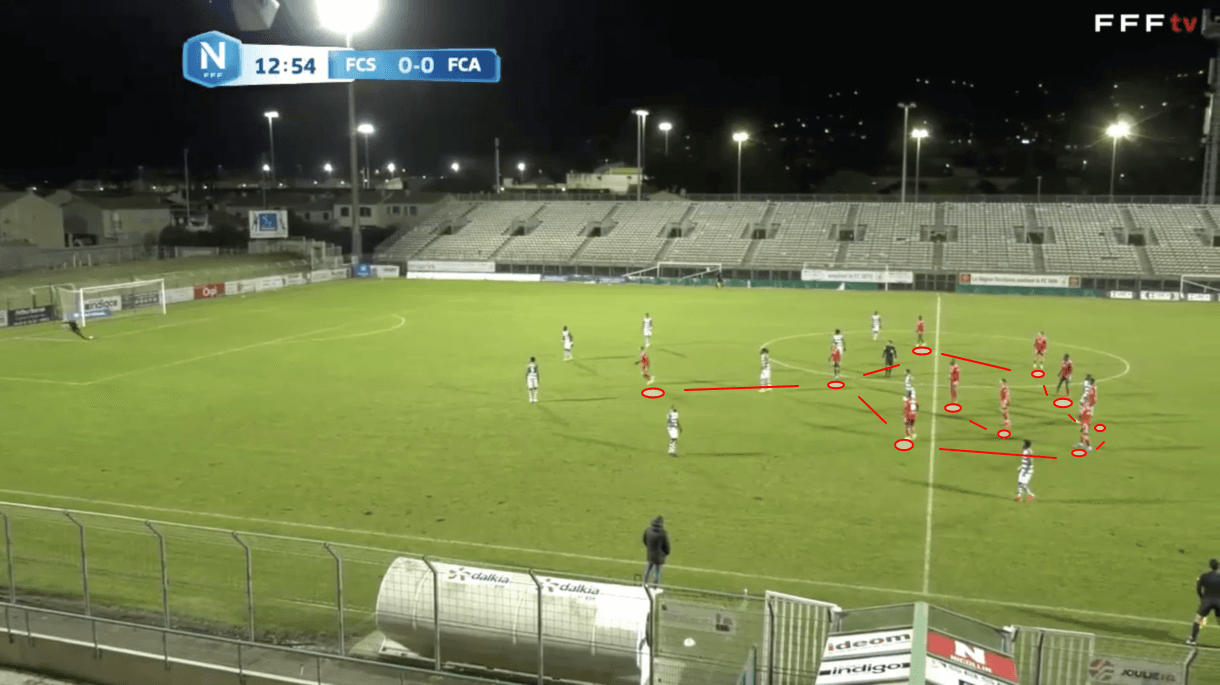
We see an example of Annecy’s defensive shape as the opposition line up a goal-kick in figure 1. Annecy have a very narrow shape here, which is typical for most teams when defending a long goal-kick. However, in general, Annecy’s 4-4-2 is extremely narrow. They are happy to offer up more space in deeper areas on the wings to buff up their central protection.
They tend to operate with a very high line, as is evident from figure 1 too with the backline holding their ground just behind the halfway line, squeezing the opposition into a tighter space. Additionally, specifically when defending long goal-kicks, it’s common to see Annecy pack bodies into the area just in front of the back-four, which is also evident in this image, with the two central midfielders, two wingers and withdrawn centre-forward all offering some protection in this area at this moment. This helps Annecy to win second-balls and make it more difficult for the opposition to do so as there’s very little space for them to attack bouncing balls in between the lines. Packing this area in front of the back-four also gives opposition attackers no space to drop off into which limits what they can do in terms of contesting aerial duels.
This image also shows how the furthest-forward striker remains alert to any potential short goal-kick here by pressing the backline.
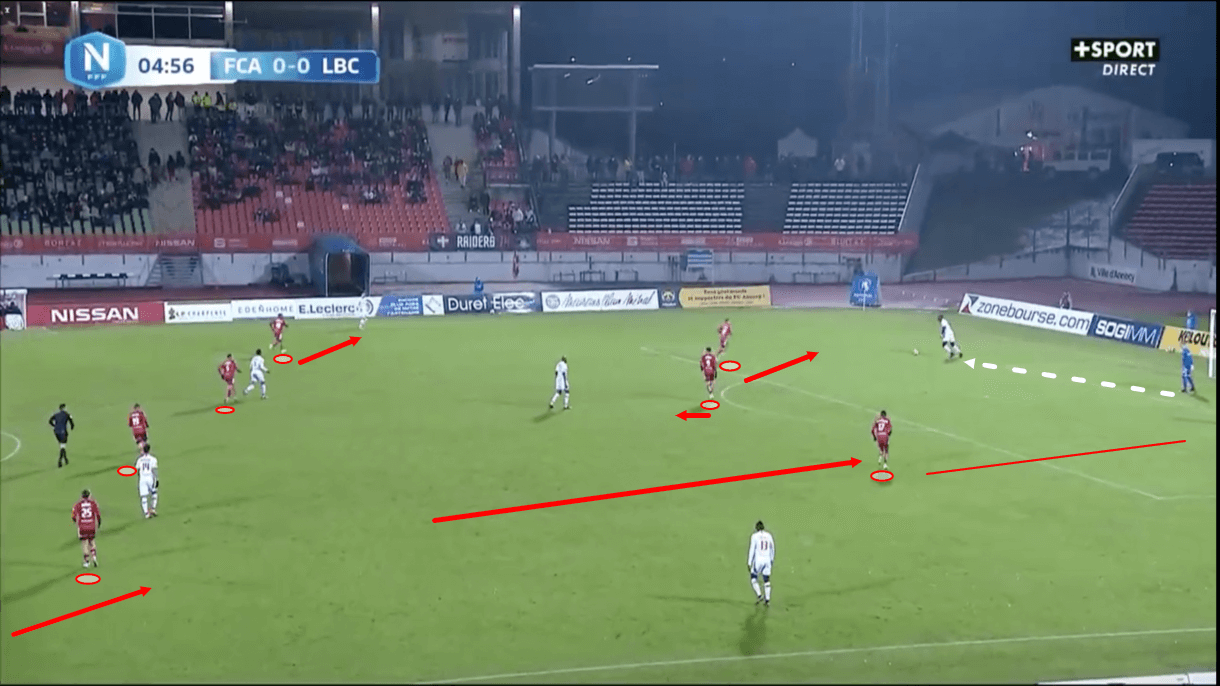
When pressing high, it’s very common to see Annecy committing three bodies to the first line of pressure, which was the case in figure 2. One of their two wingers will join the two forwards to help them match up numerically with the opposition’s two centre-backs and deepest midfielder — a common set-up for Annecy to face — as we see above. When this happens, the full-back on the side of the winger who’s joined the first line of pressure will push up to take the winger’s place in midfield. That happened here in figure 2 with the right-winger joining the two centre-forwards and the right-back subsequently becoming a temporary right-winger. This creates something of a temporary 3-4-3 shape for Annecy in the early defensive phase.
This is quite an aggressive move from Annecy but it’s typical of their game. Guyot likes his team to contest for the ball early and as far away from their own goal as possible, hence why they commit so many bodies to the first line of pressure and then take a body out of the backline to replace that winger in midfield. From here, their players’ individual defensive abilities, alertness and work-rate, along with the team’s collective defensive organisation, is the key for them in preventing the opposition from cutting through them and exposing that weakened backline, and hopefully, for them, winning the ball high to create a dangerous transition.
As was the case in figure 2, it’s very common to see one of Annecy’s centre-forwards marking the opposition’s deepest midfielder quite tightly, while his strike partner presses the ball-carrier — typically one of the two centre-backs — with the support of the winger who’s joined the forward line who also retains access to one of the two centre-backs.
Annecy get very narrow when pressing. Initially, they’ll be a bit more spread out, prioritising central protection but with the wide men in the second line of pressure retaining access to the opposition’s deepest wide men — typically the full-backs. As the opposition initiate their attack, playing their first pass — often to one of the two centre-backs — Annecy’s ball-far wide man and the ball-far central midfielder will get more central, essentially allowing the opposition wide man on the far side to enjoy plenty of freedom. They’re more concerned with protecting the central space and pressing the nearer passing options at this point than they are about guarding against the potential switch that the aggressive pressure on the ball-carriers and the near passing options should hopefully prevent. Again, figure 2 shows an example of this with Annecy’s opponents playing through their right centre-back and Annecy then leaving the opposition left-back in a lot of space.
Even when the ball is played on their side, Annecy’s ball-near wide man generally remains quite central, though of course they retain access to the ball-near opposition wide man far more than we see on the ball-far side. Still, though, their priority is beefing up the centre. It’s more the responsibility of the ball-near attacker in the first line of pressure to cut off the passing lane out to the deep wide man on that side by angling his run in such a way that the pass is impossible — or at least, unfavourable. This will be analysed in greater detail in our next section of analysis but the ultimate goal is to either force that centre-back long or force him back to the goalkeeper who’ll then go long. Annecy aim to force the opposition to play an uncontrolled ball into the centre where they have lots of bodies ready to contest the aerial duel and win the second ball.
Pressing high
Annecy have currently got the lowest PPDA (6.85) in National 1 for 2021/22. This essentially indicates that they’ve got the most aggressive press in the league, which is broadly achieved by the aforementioned gameplan from the previous section of analysis. In this section, we’ll go into more detail to investigate the specifics of Annecy’s aggressive press and its effectiveness. Guyot’s overall aim of engaging the opposition away from his own goal as much as possible has been very successful, with Annecy facing the fewest shots (5.82 per 90) in France’s third tier this term. This low ‘shot against’ volume has in turn been key to them generating National 1’s lowest xGA and conceding the second-fewest actual goals in the division. All of this is a direct result of the successful implementation of their defensive strategy and tactics, which will be analysed in this section of our scout report.
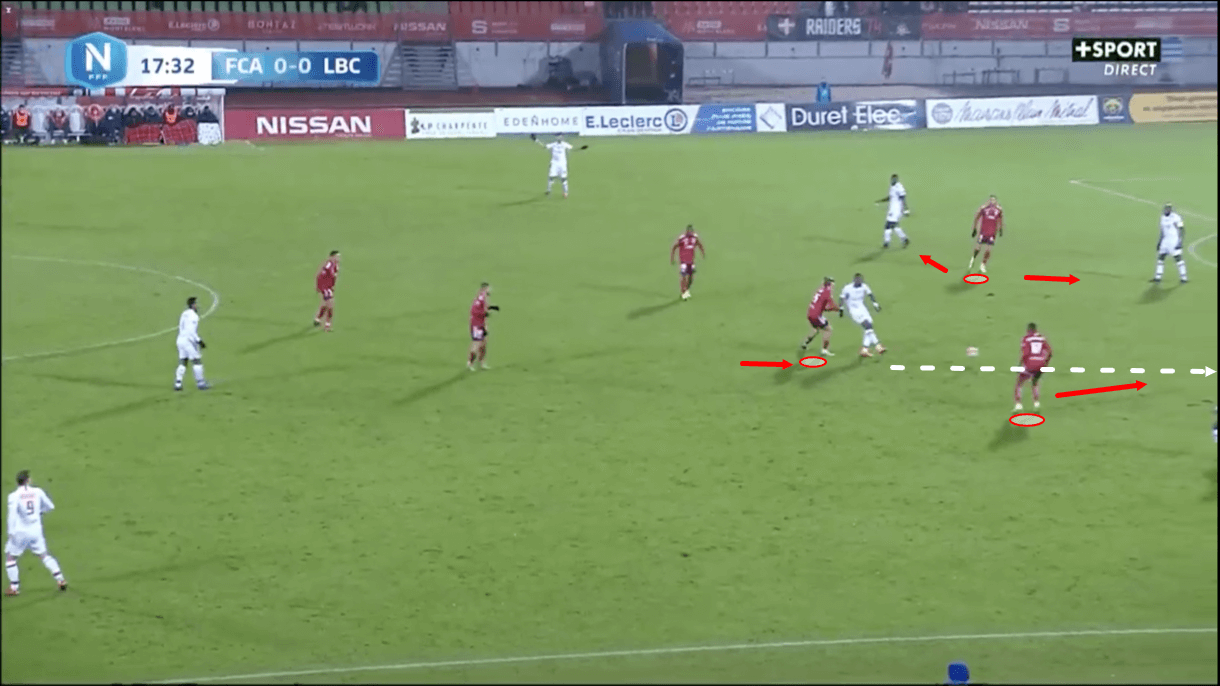
Figure 3 shows a typical example of the aforementioned pressing tactics in action with an actual in-game example. Here, Annecy’s three-man first line of defence is evident, with one attacker sitting on the opposition’s deepest midfielder — who’s actually just received the ball here but has been prevented from turning thanks to the attacker’s pressure. His strike partner is more advanced, retaining access to two deeper opposition players and effectively preventing the ball-carrier from playing out through them, so is doing a good job of cutting the pitch in half at this moment, while Annecy’s right-winger is cutting the passing lane out to the opposition left-back while retaining access to the left centre-back who the opposition ball-carrier ultimately opts to play the ball back to when under pressure.
With the opposition playing the ball out on the left side here, Annecy’s left-winger is the one who comes narrow this time, leaving the opposition’s right-back in a lot of space. We even see the right-back signalling that he wants the ball in figure 3 but Annecy’s aggressive pressure around the ball prevents this switch from being played. This shows how this element of space orientation from the ball-far winger plays out practically. By coming so centrally, this player helps Annecy to overload central midfield and guard against central progression. It’s then the responsibility of the more advanced pressing players near the ball to ensure they don’t get beat / allow the opposition enough time to play the switch.
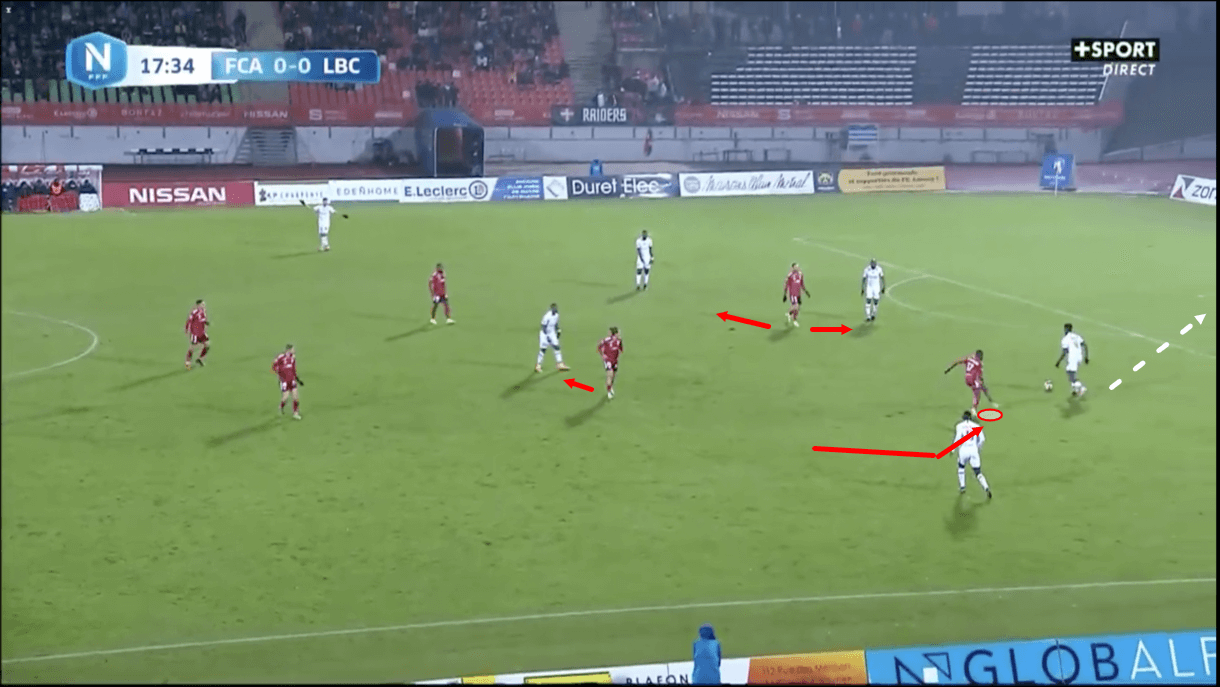
On this occasion, as the ball is played back to the opposition’s left centre-back, Annecy’s right-winger immediately springs into action with a very aggressive, yet very intelligent bit of pressure. Remember — this player was keeping the opposition’s left-back in his cover shadow and even though the ball has now been passed back to the left centre-back, who he must quickly turn his attention to and aggressively pursue, the winger intelligently remembers to angle his run in such a way that he continues keeping the left-back in his cover shadow to prevent the left centre-back from using the wide man as an out-ball. This is clear from figure 4, where we can see the right-winger closing down the left centre-back while keeping the left-back in his cover shadow. He made a clear effort to get between these two left-sided players before heading directly for the centre-back despite the potential switch of play. The winger’s speed is useful here and he does successfully get close to the centre-back before a switch could be played, leading to him successfully forcing the centre-back to go backwards to the goalkeeper.
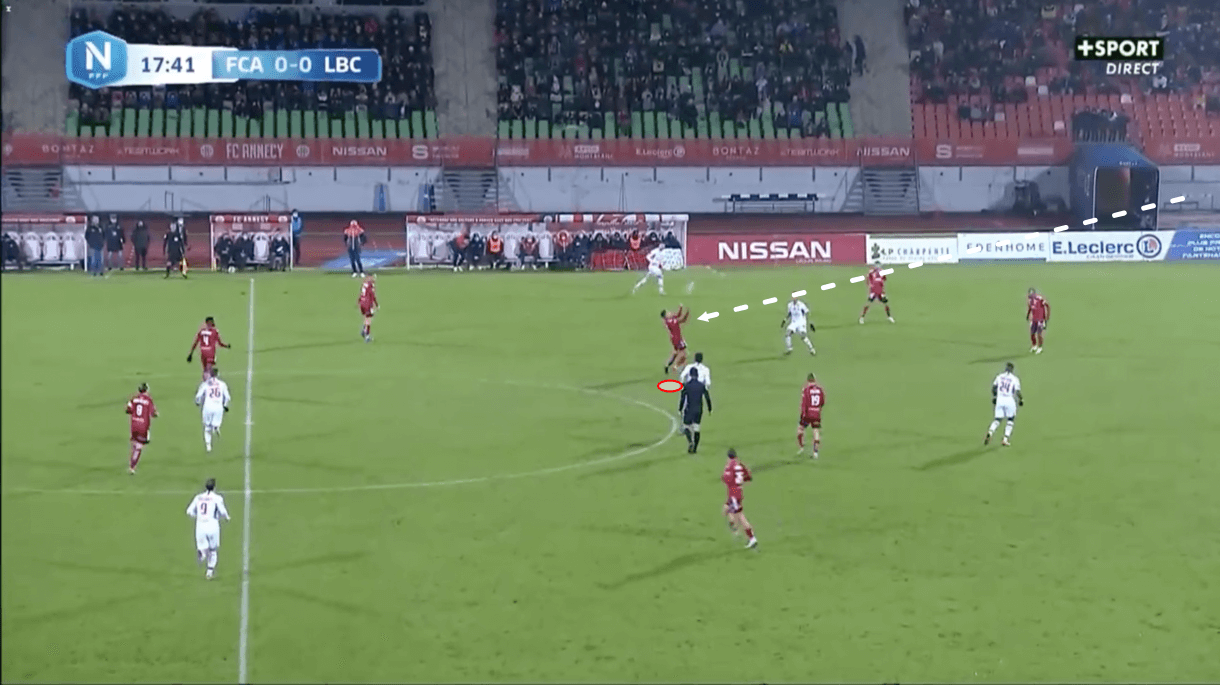
As play moves on into figure 5, we see that Annecy ultimately succeeded in forcing the ‘keeper long and into the centre, where they had plenty of bodies present to regain possession inside the opposition half, kickstarting their counter-attack. Aggressive pressure on the ‘keeper was necessary after the backpass was played from the left centre-back to force him into a rushed clearance like the one we saw, as opposed to a more accurate ball that could’ve exposed Annecy’s underloaded wings.
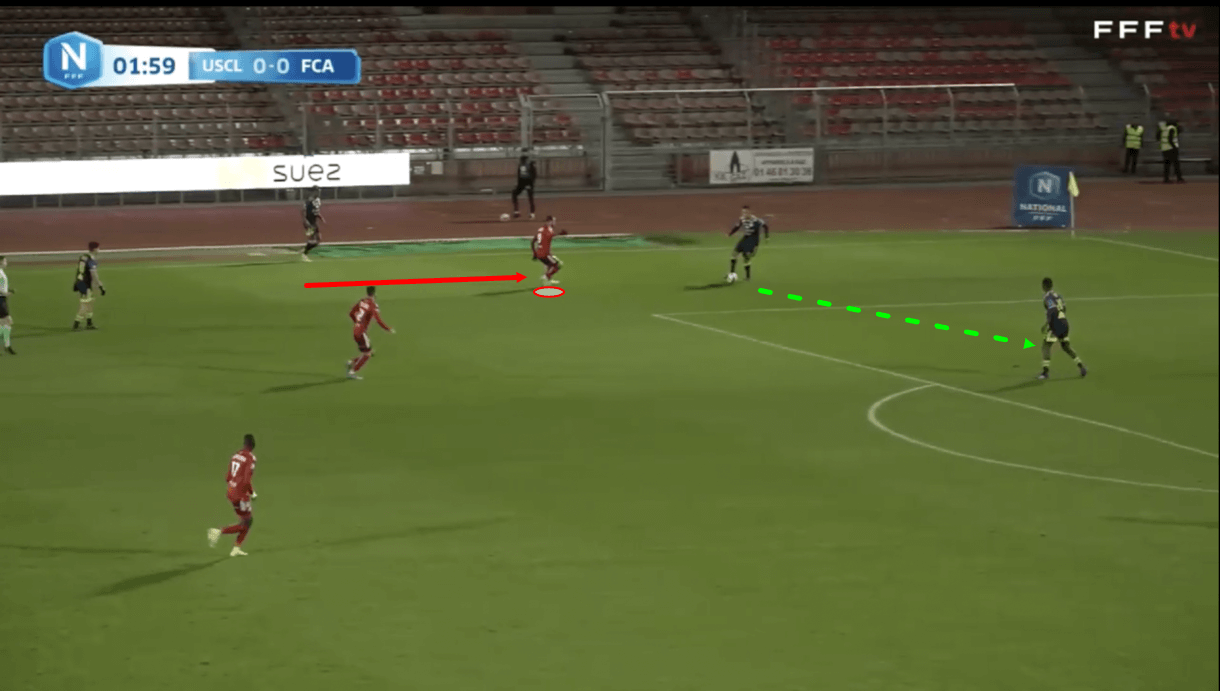
Another example of this pressing is evident in figures 6-8. Firstly, in figure 6, we see Annecy’s left-forward pressing the opposition’s right centre-back after cutting off the passing lane between him and the right-back. From here, in this position that prevents the ball from moving out wide, the striker can continue closing down the ball-carrier aggressively. This forces him to play the ball back to the central centre-back, who then immediately draws aggressive pressure from Annecy’s other centre-forward.
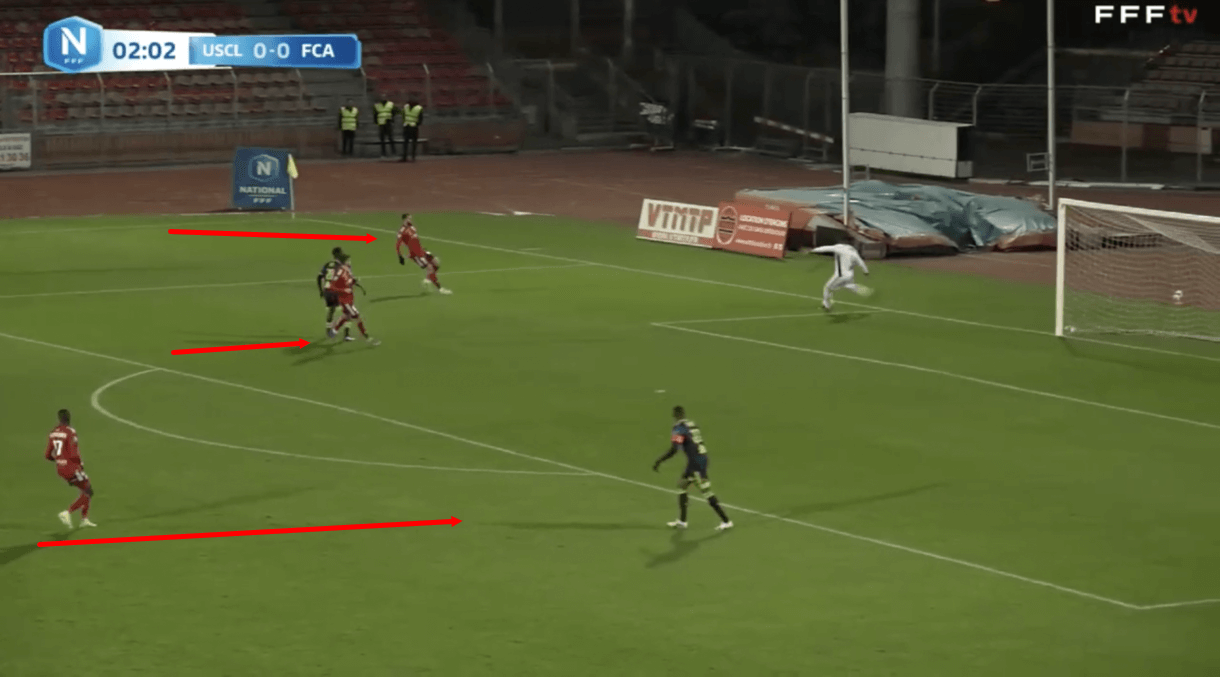
As we move on into figure 7, with the opposition’s left centre-back also attracting aggressive pressure from Annecy’s right-winger, the central centre-back was forced to play the ball back to the ‘keeper and with all the near passing options now closed off and the two forwards pursuing the backpass to the ‘keeper aggressively, he was quickly forced to send the ball long. This is an example of Annecy’s goal being achieved yet again.
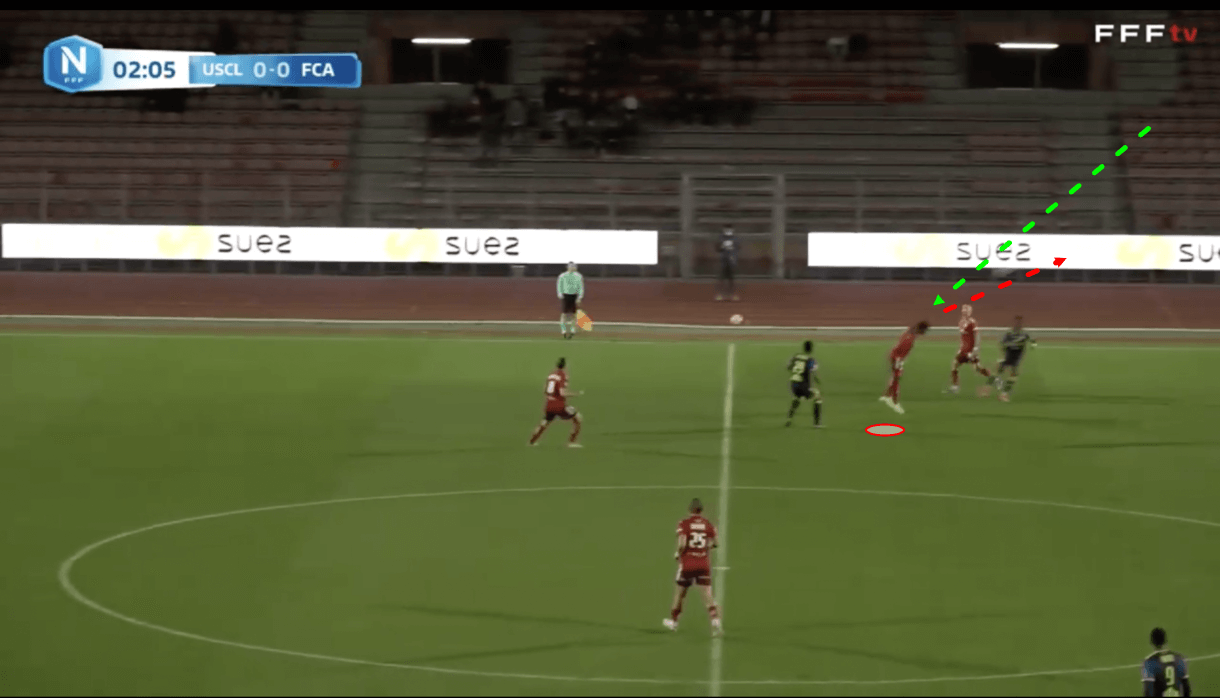
As we progress into figure 8, we again see the subsequent aerial duel in central midfield which leads to Annecy regaining possession. These defensive tactics mean that Annecy’s centre-backs and at least one of the central midfielders need to be proficient in the air. Guyot’s side has actually contested the most aerial duels (49.32 per 90) of any National 1 side by some distance this season, which is again a result of the successful implementation of their aggressive pressing tactics. So, it’s clear that their midfielders and centre-backs are called into action in this way quite a lot, and their aerial ability, along with the team’s centrally compact shape to sweep up any and all second-balls, is as important as any other element of this defensive system.
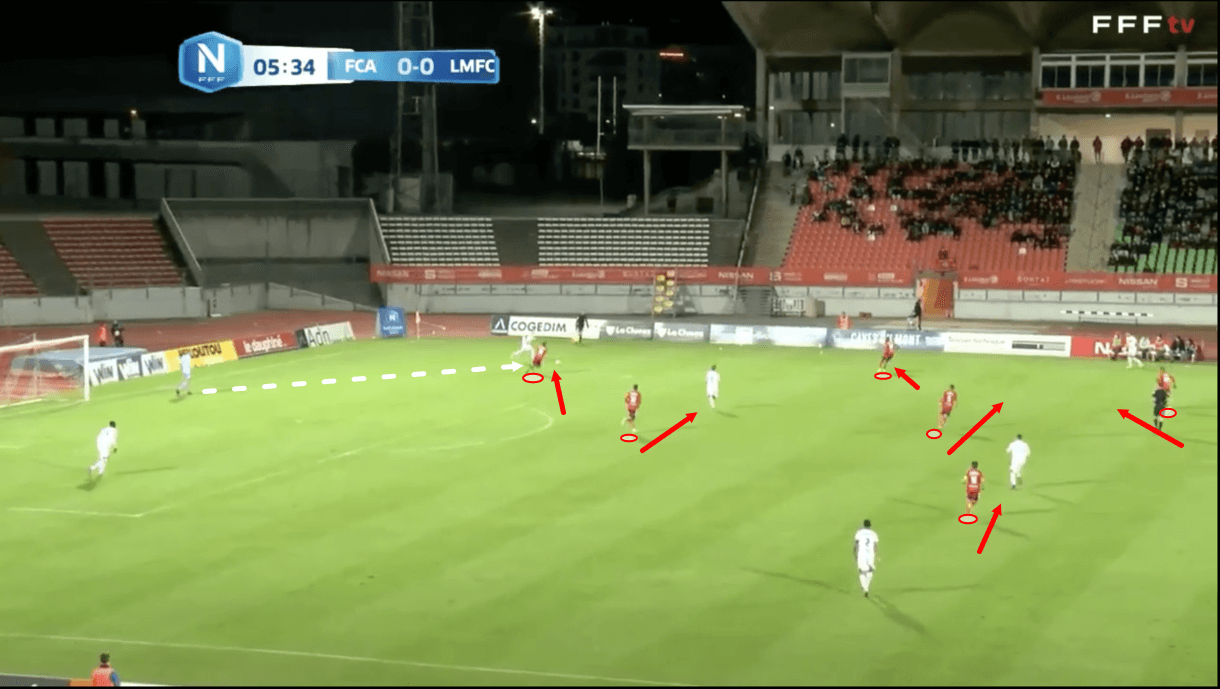
One more example of Annecy’s high pressing is shown in figures 9-11. Starting with figure 9, the image above shows Annecy defending aggressively in their 4-4-2 shape, with the right-forward leading the press by engaging the opposition’s left centre-back as he receives the short pass from the goalkeeper. Meanwhile, Annecy’s right-winger cuts off the passing lane to the full-back and the left-forward takes it upon himself to perform the deeper role and sits on the opposition’s holding midfielder. At the same time, Annecy’s two central midfielders and the left-winger push over to the right side of the pitch to congest space around the ball and back the centre.
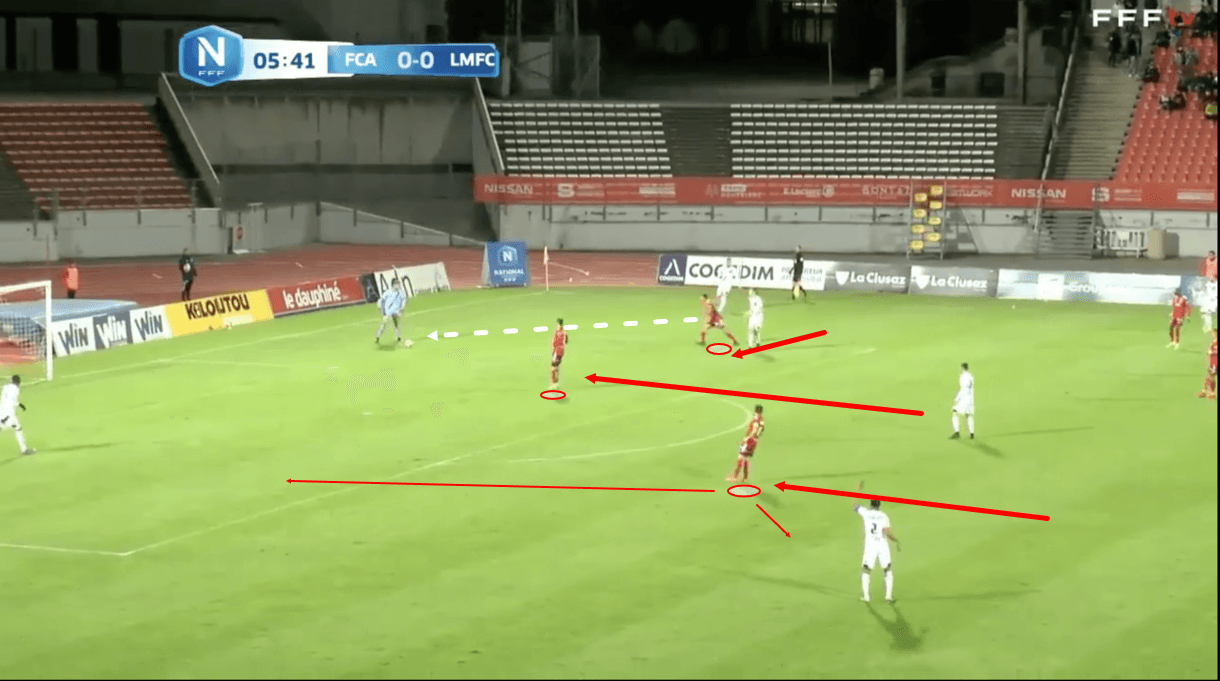
The left centre-back is, as a result of this coordinated and aggressive pressure from Annecy’s players, prevented from playing out easily and is ultimately prevented from progressing play at all, with the ball being sent back to the ‘keeper in figure 10. This opens the possibility of a switch to the opposite wing, but Annecy’s strikers and left-winger jump into action as the backpass is played, cutting off the ‘keeper’s near-passing options and retaining access to the left centre-back, who the ‘keeper would still have to turn to pass to safely at this point, which wasn’t easy when under aggressive pressure from Annecy’s first line of defence.
This is an example of the alertness, anticipation and work rate of Guyot’s team. They don’t waste any time in implementing their manager’s defensive tactics and react quickly to the opposition’s moves to keep pressure on the opposition’s backline and prevent any ball progression. The coordinated nature of their pressing is also highly impressive — Guyot’s men know exactly where they need to be and how they need to react to specific opposition decisions within this defensive system and their familiarity with the manager’s plans helps them to perform these defensive actions like clockwork. This high level of coordination and defensive organisation is key to their success as a defensive unit.
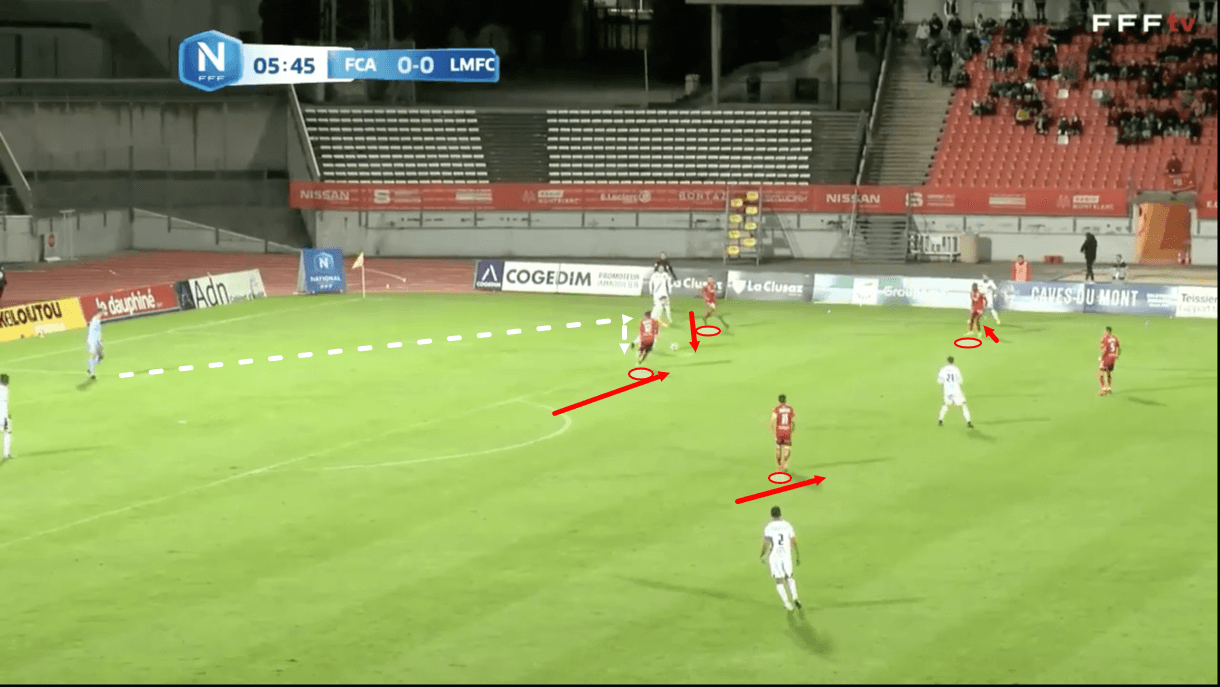
The opposition ‘keeper ends up sending the ball back out to his left centre-back rather than sending it long and on this occasion, the left centre-back aims to play through Annecy despite their well-coordinated pressure and organised defensive shape. In figure 11, we see that the centre-back plays the ball to his holding midfielder who immediately comes under pressure from Annecy’s left-forward. With Annecy congesting this area of the pitch and now doubling up on the ball-carrier with their two strikers, a turnover is forced in a very dangerous area of the pitch. This highlights that if the opposition try to play through Annecy despite their aggressive pressure, perhaps to avoid sending the ball long to an area in which Guyot’s side have an advantage, it can just as easily result in an even more dangerous turnover of possession.
Annecy have capitalised on ‘keepers’ and defenders’ technical limitations to an extent in how they allow more space out wide for potential switches of play, knowing that their aggressive pressure will likely be enough to prevent that accurate long ball from the National 1 opponents. The fact players struggle to hit this switch under Annecy’s pressure lowers the opportunity cost of packing the centre at the expense of allowing space to open on the ball-far wing, meaning that this is less of a gamble for them than it could be.
Defensive transitions
Lastly, I’ll spend the final section of this tactical analysis and scout report looking at Annecy’s defensive transitions. Without going into great detail on their offensive game, Annecy are a fairly direct side who try to implement a very vertical game. This has seen them make the most ball losses (112.97 per 90) of any National 1 side this season — not a statistic you generally want to be topping but one that’s more a result of their aggressive offensive style than it is a result of technical deficiencies in their offensive game. This is often a result of long balls or aerial duels being lost against opposition defenders but on occasion, their aggressive attacking can show some technical issues or impatience more than anything else.
Given that they turn over the ball so much, Annecy’s performance in defensive transitions is extremely relevant as they perform many of them. Again, with many of their ball losses resulting from long balls and aerial duels, these turnovers won’t be particularly dangerous as they won’t be far off their general narrow and compact defensive 4-4-2 shape. However, they’re not complete strangers to giving the ball away in more dangerous situations and how they react in such scenarios is very relevant.
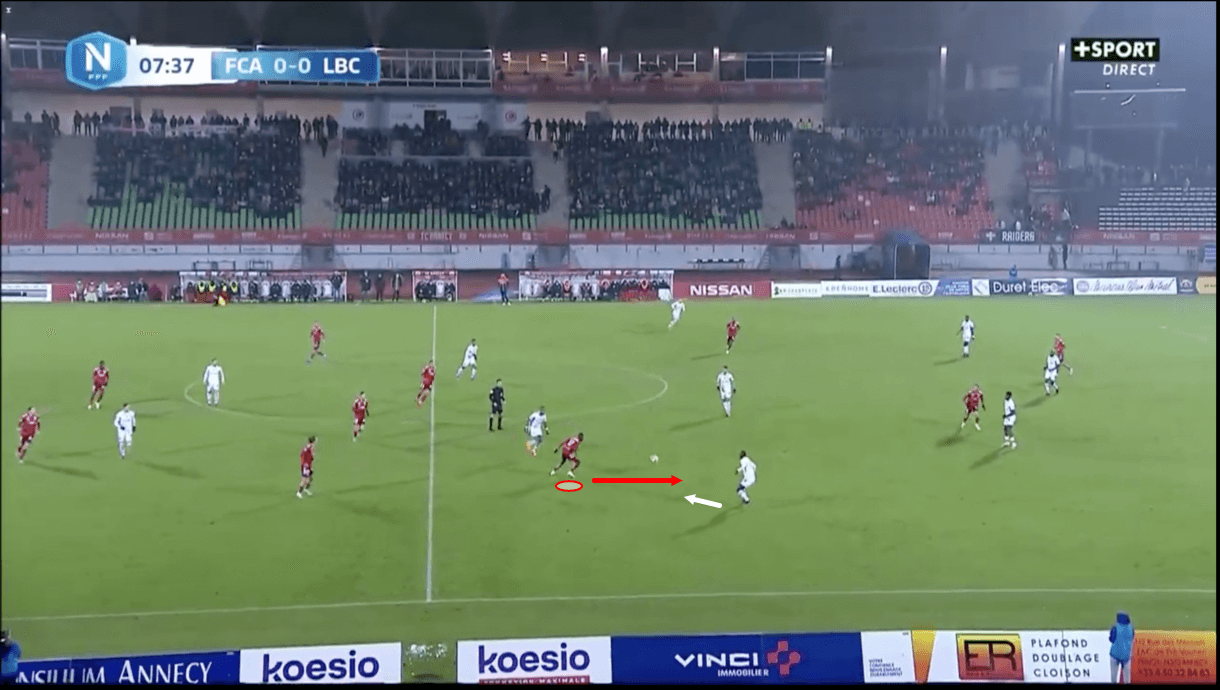
Firstly, figure 12 shows an example of Annecy’s right-winger giving the ball away cheaply in the middle third of the pitch after his first touch took control away from him, giving the opposition’s left wing-back a chance to regain possession. As the ball makes its way to the wing-back here, note the lay of the land around the rest of the pitch. There is a clear passing lane open into midfield for this wing-back to potentially exploit, while there’s also some space on the left wing for the wing-back to drive down with the ball himself.
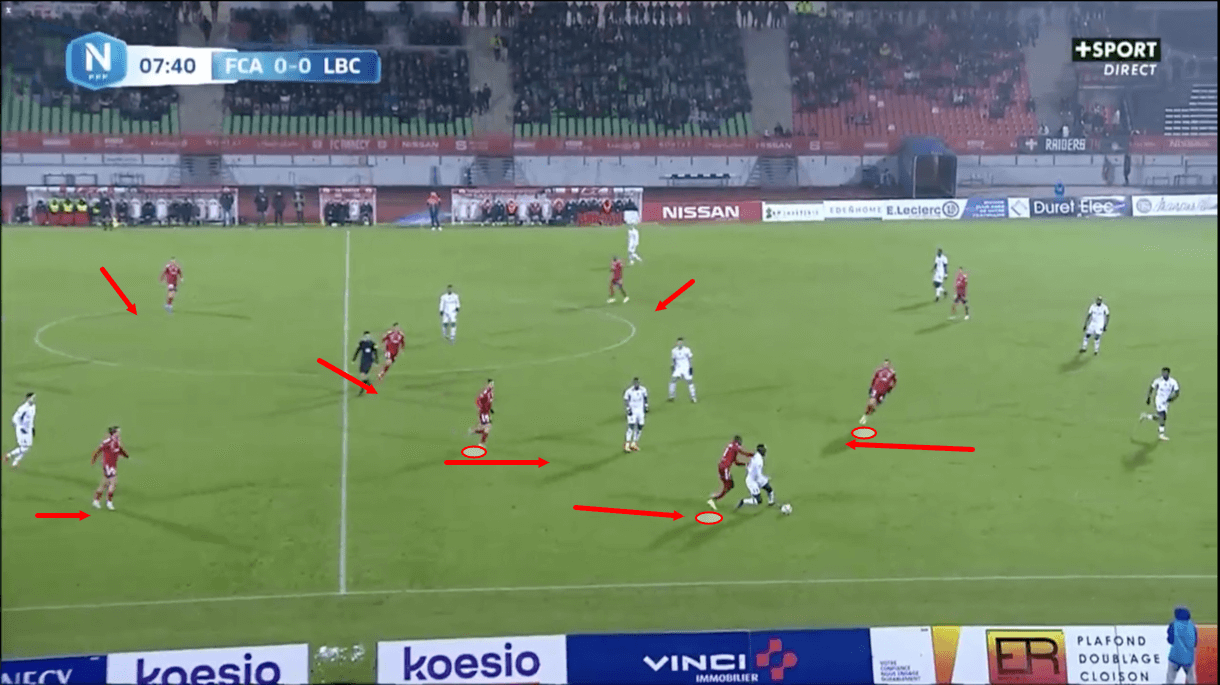
However, as the wing-back actually gets possession in figure 13, Annecy’s right-winger has closed him down and forced him to turn to protect the ball, while Annecy’s central midfielders and backline have pushed up to compress some of the space in midfield, while the ball-near centre-forward has also dropped to compress the central space from the other direction.
Figure 12 and Figure 13 are taken just three seconds apart but the difference in the amount of free space the opposition have in central midfield, as well as the difference in the amount of space the left wing-back has, is significant. At the same time as the team compressed space vertically from both ends of the pitch, Annecy also shifted over to the right-wing to create more horizontal compactness as well. This made them a much more challenging unit to play through.
This immediate, automatic response from Annecy to this turnover all around the pitch is another testament to how well prepared this team is to carry out Guyot’s gameplan. They defend very intelligently and even in this potentially very dangerous moment of transition, they act very rationally, compressing space from all angles quickly and effectively to prevent the opposition from progressing.
As mentioned at the beginning of this scout report, Annecy play with a very high line and at times, the opposition attempt to counter-attack very directly by targeting the space behind Annecy’s backline with a long ball — especially one targeting the space they leave open out wide in deep areas. In such situations, the backline’s recovery pace is called into action, as is the centre-backs’ ability to defend effectively in wide areas. Annecy play very aggressively all around the pitch and most of the time, thanks to the organisation that Guyot has helped to instil in them, they succeed while playing so aggressively. This includes centre-backs being dragged out wide to defend aggressively and with Annecy boasting a highly impressive defensive duel success rate of 63.9% this season, their centre-backs are among those players with the best defensive duel success rate of all, highlighting their suitability for this aggressive system and vice versa.
Conclusion
To conclude this tactical analysis piece and scout report, I hope it’s clear how Guyot and Annecy’s defensive gameplan has made them incredibly difficult to break down this season, resulting in their low shot against count, low xGA, and most importantly, low goals conceded. While they’re outperforming xG in front of goal to a major extent at the moment, their positive defensive record is indisputable and a clear result of the clean implementation of their interesting gameplan. Should they continue to defend with such coordination, organisation and energy in the second half of the season, then Guyot may well guide this club that’s risen through the French football ranks at great speed in recent years to the cusp of yet another promotion, which would be an incredible achievement given where they spent the majority of the last three decades, built on their defensive solidity this season.




Comments